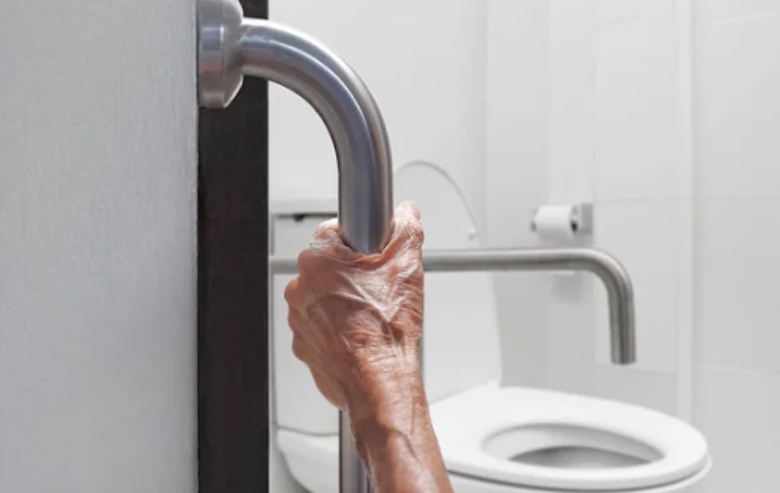The simple fact is we are all ageing. Our body, and sometimes our mind, betrays us, and things that were once simple now require a little extra consideration, care and support. This is especially true when it comes to the intimate and often sensitive matter of toileting. Whether it’s a loved one who is ageing or dealing with illness, providing assistance with toileting is a natural and essential part of caregiving. In this article, we will unpack some practical steps, emotional considerations, and safety tips to ensure a respectful and supportive toileting experience.
Creating a Supportive Environment
Before delving into the practicalities of assisting an adult with toileting, it’s important to create a safe and supportive environment. Making a few adjustments can go a long way to ensuring comfort and safety.
1. Home Modifications: Set up the living space to cater to their needs.
– Install handrails near the toilet,
– consider a removable raised toilet seat for added comfort, and
– keep essential items like wet wipes and toilet paper within easy reach.
2. Bathroom Routine:
Learn your loved one’s toileting routine and make regular trips to the bathroom throughout the day. Avoid rushing and allow ample time for each step.
3. Hygiene and Safety:
Always prioritise hygiene by washing your hands before and after assisting and wearing gloves as needed. Additionally, consider using waterproof mattress pads and incontinence pads to minimise mess and discomfort. Both are available from WINFAR, on request.
Guiding the Process
When assisting an adult with toileting, approach the task with patience and a compassionate mindset.
Effective communication is key, so talk through each step to provide clarity and reassurance.
1. Work Together:
– Walk slowly together to the bathroom or commode.
– Once there, ask your loved one to turn around so the toilet is directly behind them.
– Position yourself to provide stability by placing your hands on their hips or waist.
2. Sitting and Standing Safely:
– Encourage your loved one to do as much as possible themselves.
– Support them by guiding their movements with your hands on their trunk and hips.
– When sitting down or standing up, remember to bend your knees to protect your back and maintain their stability.
3. Using a Bedpan:
If getting out of bed is a challenge, assist them with a bedpan.
Ensure their privacy, create a comfortable sitting position, and provide gentle support throughout the process. Use incontinence pads and maintain dignity with patience and care.
Overcoming Emotional Barriers
Assisting someone with toileting can be emotionally challenging for both parties. It’s important to address any embarrassment or discomfort openly.
1. Promote Independence:
Encourage your loved one’s participation as much as possible. Studies show that feeling supported in daily activities fosters a sense of independence and control, leading to better emotional well-being.
2. Remain Positive:
A sense of humour can be a invaluable tool in relieving tension and discomfort. Laughter, when shared appropriately, can help both you and your loved one cope with the situation.
Safety First: Preventing Injuries
Safety is paramount when assisting an older adult with toileting.
Follow these tips to reduce the risk of accidents and injuries:
1. Balance Support:
– Your role is to provide balance support, not bear their full weight.
– Avoid lifting them or having them hold onto you as this can increase the risk of injury to both you and your loved one. Instead, place your hands on their hips and waist to maintain stability. Bend your knees as they sit down or lift themselves back up and avoid pulling on their arms.
Always hold onto their trunk and hips, not their arms or legs.
2. Clear Communication:
Communicate each step clearly and give your loved one time to respond and follow instructions.
3. Assist, Don’t Lift:
Avoid lifting them outright or placing excessive weight on yourself.
This minimizes the risk of injury to both of you.
4. Bend Your Knees:
When assisting with sitting or standing, always bend your knees to protect your back and maintain stability.
How to sit and stand safely
- Once your person is in front of the toilet, allow them to slowly turn around and face you. Don’t let them hold on to their walker as they sit or stand because it could tip over and cause a fall. Rather have them hold onto your forearms.
- When positioned, with the toilet seat directly behind them, ask them to lower themselves slowly onto the toilet seat while holding onto your forearms. If necessary steady them with your hands on their trunk. Bend your knees as they lower themselves.
- Before standing up, ask them to scoot forward a little and place their hands on your forearms before slowly raising themselves up. Keep your hands on their trunk, your feet solidly planted and bend your knees.
Promoting Dignity and Comfort
Maintaining your loved one’s dignity and comfort throughout the toileting process is essential. Focus on these principles:
1. Communication:
Whenever you help an adult with toileting, have patience and keep a light, down-to-earth perspective. Good communication is helpful, so be sure to talk through the process as you move through the steps
2. Privacy:
Ensure privacy by closing doors or curtains and providing space for your loved one to feel comfortable.
3. Modesty:
Respect their modesty by using incontinence pads, adjusting clothing, and providing privacy whenever possible.
4. Independence:
Encourage their participation and allow them to take an active role whenever feasible.
Assisting an adult with toileting is a deeply personal and compassionate act of caregiving. It may seem intimidating, but if you approach it with a matter-of-fact demeanour, it will be easier for both of you. By creating a supportive environment, focusing on safety, and prioritising emotional well-being, you can provide valuable assistance while preserving your loved one’s dignity and comfort. Remember, your intention is to help, support, and ensure their well-being, making their journey through this stage of life as comfortable and dignified as possible.
Source articles:
https://www.mariecurie.org.uk/help/support/being-there/caring/helping-someone-use-the-toilet
https://www.crossroadshospice.com/hospice-palliative-care-blog/2021/march/18/how-to-help-an-adult-with-toileting
https://www.caringseniorservice.com/
https://www.visitingangels.com/knowledge-center/family-caregiver-support/what-to-do-when-your-aging-parent-needs-help-in-the-bathroom/450
https://www.linkedin.com/pulse/tips-assisting-elderly-parent-bathroom-darlene-kemp-mph-mba-hcm/

